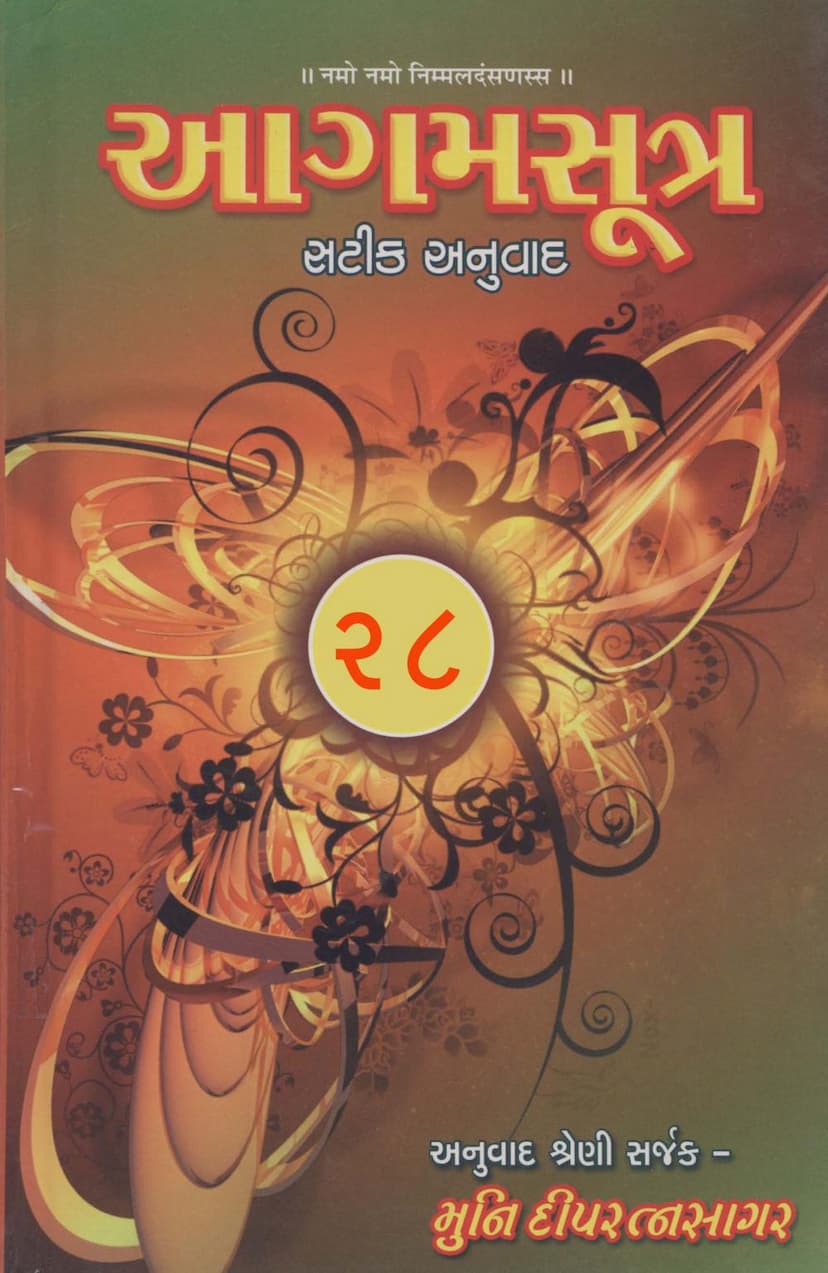Agam 19 Nirayavalika Sutra Satik Gujarati Anuvad
Added to library: September 1, 2025

Summary
This document is an excerpt from the Gujarati translation and commentary of Jain Agamas, specifically Volume 28, which focuses on Nirayavalika Sutra. The following is a comprehensive summary:
Overall Scope and Purpose:
The document belongs to a larger series of "Agam Sutra Satik Anuvad" (Agam Sutra with Commentary Translation), comprising 42 volumes. This particular volume (Part 28) is dedicated to translating and explaining the Nirayavalika Upanga Sutra and other related Pannasutta (Pannasutra). The project aims to make the profound Jain scriptures accessible to a wider audience through Gujarati translations and detailed commentaries.
Content of Volume 28:
- Title: Agam 19 Nirayavalika Sutra Satik Gujarati Anuvad (Agam Sutra with Commentary Translation, Volume 19: Nirayavalika Sutra).
- Author/Translator: Muni Deepratnasagar (Muṇi Dīparatnasāgara).
- Focus: This volume covers 15 Jain Agamas, categorized into two main groups:
- Nirayavalika-Panchak (Five Nirayavalika Sutras): These are Upanga Sutras 8 to 12:
- Nirayavalika (Hell-like situations/states)
- Kalpavamsika
- Pushpika
- Pushpchulika
- Vrishni Dasha (The condition of the Vrishnis)
- Dash Payanna (Ten Pannasutta): These are generally considered auxiliary scriptures. The specific ones included in this volume are:
- Chatuh Sharan (Four Refuges)
- Atur Pratyakhyan (Renunciation by the Sick)
- Mahapratyakhyan (Great Renunciation)
- Bhakt Parigya (Renunciation by a Devoted Person)
- Tandul Vaicharik
- Samstarak (Renunciation on a Bed of Straw)
- Gachchachar (Conduct of the Community)
- Ganividha
- Devendrastava (Praise of Indra)
- Virastava (Praise of Vira)
- Chandravedhyak (This is listed as an optional inclusion, making it 10 + 1 = 11 Pannasutta).
- Nirayavalika-Panchak (Five Nirayavalika Sutras): These are Upanga Sutras 8 to 12:
- Commentary: The volume incorporates the commentary (Vritti) by Shri Chandrasuri for the five Upanga Sutras, presented in two translated versions. For Chatuh Sharan and Tandul Vaicharik, the commentary by Vijay Vimal Gani is used. For Atur Pratyakhyan and Samstarak, the Avachuri by Gunratnasuri is included. For Gachchachar, the Laghuvritti Avadhuri by Shri Vanarshi is used. For the remaining Pannasutta, only the essential meaning is provided. The commentary of the Achalgachchhiya tradition is not included.
- Key Themes in the Translated Sutras (Example from Nirayavalika): The provided text includes a detailed translation and explanation of the first few sutras and their commentaries. These sections narrate:
- The setting of Rajagriha city, a Guanashila Chaitya, and an Ashok tree.
- The presence and teachings of Arya Sudharma, a chief disciple of Lord Mahavira, accompanied by 500 ascetics.
- The young ascetic Jambu, a disciple of Sudharma, engaged in deep meditation.
- Jambu's inquiry to Sudharma about the meaning of the Upanga Sutras and their classification.
- The classification of Upangas into five groups and the description of the ten chapters (Adhyayana) within the Nirayavalika.
- A detailed narrative about the first chapter of Nirayavalika, which recounts the lineage and tragic events related to King Konika, his parents Shrenika and Chelana, his mother Kali, and his son Kala Kumar. This includes the story of Kala Kumar's war, death, and subsequent rebirth in hell.
- The narrative continues with the birth of Abhayakumar and Konika, highlighting the complex relationships and events that led to the downfall of Konika.
- The story of Vehalla Kumar, Konika's brother, his possession of valuable elephants and necklaces, and his flight to his maternal grandfather, King Chetaka of Vaishali.
- The escalating conflict between Konika and Chetaka, culminating in a major war.
- The consequences of these actions, including Kala Kumar's death and rebirth in hell.
- The text details the karma associated with these actions and predicts future lives and eventual liberation.
Publisher and Support:
The publication is supported by various Jain Sangh (organizations) and trusts, indicating a collaborative effort to make these scriptures available. The front matter also expresses gratitude to various Acharyas and Munis who inspired and financially supported this extensive project.
Other Publications by the Publisher:
The document also lists other publications by the same author/publisher, showcasing a vast library of Jain literature covering:
- Original Agamas (in multiple volumes).
- Gujarati translations of Agamas.
- Agamas with detailed commentaries (Agam Sutra Satik).
- Index of Agamic subjects (Agam Vishay Suchi).
- Agamic dictionaries (Agam Kosha, Agam Nam Kosha).
- Hindi translations of Agamas.
- Compilations of Agamic stories (Agam Katha-anuyog).
- Rituals and ceremonies related to Agamas (Agam Mahapujan Vidhi).
- Grammar, philosophy, worship, and miscellaneous Jain literature.
Overall Significance:
This volume of Nirayavalika Sutra Satik Anuvad is a significant contribution to Jain scholarship and practice. It aims to elucidate the complex narratives and philosophical teachings within these ancient scriptures, making them accessible for study and contemplation by a broader audience, particularly those who can engage with Gujarati. The detailed narrative portions, especially the historical and karmic accounts, are central to understanding the ethical and spiritual lessons embedded within the Nirayavalika.